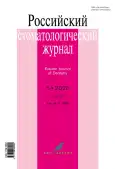Comparison of the strength characteristics of direct and indirect dental restorations under uniaxial compression
- 作者: Enina Y.I.1, V. A.V.1, Dorofeev A.E.1, Ershov K.A.1, Pustokhina I.G.1
-
隶属关系:
- FGAOU VO "First Moscow State Medical University named after I.M. Sechenov "Ministry of Health of Russia (Sechenov University)
- 期: 卷 24, 编号 5 (2020)
- 页面: 293-296
- 栏目: Experimental and Theoretical Investigation
- URL: https://journals.rcsi.science/1728-2802/article/view/61022
- DOI: https://doi.org/10.17816/1728-2802-2020-24-5-293-296
- ID: 61022
如何引用文章
全文:
详细
An urgent task in modern restorative therapeutic dentistry is to make a decision in each specific clinical case, which is justified not only from the esthetic and medical, but also from the economic, as well as the biomechanical and ergonomic points of view. According to many authors, the key to the successful restorative treatment of hard tissue defects of any genesis is to understand the etiological causes and conditions of their occurrence, as well as to assess the size of the defect and the level of material and technical base of modern dentistry.
Long-term results of esthetic restoration of teeth using the direct method with various composite materials indicated the admission of multiple errors and complications, such as inconsistency in the color and transparency of the filling; violation of the marginal adherence; and the appearance of marginal staining along the border of the composite material with the tooth tissues, both during and in various terms after treatment.
In contrast to the direct method of restoration, the ceramic inlay is made indirectly. This allows reducing polymerization shrinkage, which in turn improves marginal adherence and reduces the frequency of caries recurrence.
作者简介
Y. Enina
FGAOU VO "First Moscow State Medical University named after I.M. Sechenov "Ministry of Health of Russia (Sechenov University)
Email: avsevbitov@mail.ru
俄罗斯联邦, 8-2, Trubetskaya street, Moscow, 119992
A. V.
FGAOU VO "First Moscow State Medical University named after I.M. Sechenov "Ministry of Health of Russia (Sechenov University)
编辑信件的主要联系方式.
Email: avsevbitov@mail.ru
Dr Sci. Med., Professor, Head of the Department
俄罗斯联邦, 8-2, Trubetskaya street, Moscow, 119992A. Dorofeev
FGAOU VO "First Moscow State Medical University named after I.M. Sechenov "Ministry of Health of Russia (Sechenov University)
Email: avsevbitov@mail.ru
俄罗斯联邦, 8-2, Trubetskaya street, Moscow, 119992
K. Ershov
FGAOU VO "First Moscow State Medical University named after I.M. Sechenov "Ministry of Health of Russia (Sechenov University)
Email: avsevbitov@mail.ru
俄罗斯联邦, 8-2, Trubetskaya street, Moscow, 119992
I. Pustokhina
FGAOU VO "First Moscow State Medical University named after I.M. Sechenov "Ministry of Health of Russia (Sechenov University)
Email: avsevbitov@mail.ru
俄罗斯联邦, 8-2, Trubetskaya street, Moscow, 119992
参考
- Ревазова З.Э., Рижинашвили Т.А. Клиническое обследование больных в терапевтической стоматологии // Терапевтическая стоматология: Национальное руководство / Под ред. Л.А. Дмитриевой, Ю.М. Максимовского. М. : ГЭОТАР-Медиа, 2009. С. 121–141.
- Дмитриева Л.А., Бобр И.С. Оперативная техника лечения зубов // Терапевтическая стоматология: Национальное руководство / Под ред. Л.А. Дмитриевой, Ю.М. Максимовского. М. : ГЭОТАР-Медиа, 2009. С. 359–391.
- Лебеденко И.Ю., Узунян Н.А. Профилактика ошибок при выборе цвета зубов // Российский стоматологический журнал. 2005. № 4. С. 22–25.
- Гарбер Д.А. Эстетическая реставрация боковых зубов. Вкладки и накладки. М. : МЕДпресс-информ, 2009. 152 с.
- Wood I., Jawad Z., Paisley C., Brunton P. Non-carious cervical tooth surface loss: a literature review // J Dent. 2008. Vol. 36. N 10. P. 759–766. doi: 10.1016/j.jdent.2008.06.004.
- Aw T.C., Lepe X., Johnson G.H., Mancl L. Characteristics of noncarious cervical lesions: a clinical investigation // J Am Dent Assoc. 2002. Vol. 133. N 6. P. 725–733. doi: 10.14219/jada.archive.2002.0268.
- Francisconi L.F., Graeff M.S., de Moura Martins L., et al. The effects of occlusal loading on the margins of cervical restorations // J Am Dent Assoc. 2009. Vol. 140. N 10. P. 1275–1282. doi: 10.14219/jada.archive.2009.0051.
- Nascimento M.M., Gordan V.V., Qvist V., et al. Restoration of noncarious tooth defects by dentists in The Dental Practice-Based Research Network // J Am Dent Assoc. 2011. Vol. 142. N 12. P. 1368–1375. doi: 10.14219/jada.archive.2011.0138.
- Tyas M.J. The Class V lesion-aetiology and restoration // Aust Dent J. 1995. Vol. 40. N 3. P. 167–170. doi: 10.1111/j.1834-7819.1995. tb05631.x.
- da Conceição Dantas de Medeiros F., De Araújo-Silva T.F., Alves Ferreira K., et al. Use of dental prostheses and their relationship with oral lesions // Rev Salud Publica (Bogota). 2015. Vol. 17. N 4. P. 603–613. (In Portuguese). doi: 10.15446/rsap.v17n4.34322.
- Севбитов А.В., Браго А.С., Енина Ю.И. Опыт применения гибридной керамики для реставрации зубов в цервикальной области // Клиническая стоматология. 2017. № 3. С. 10–12.
- Николаев А.И., Цепов Л.М. Практическая терапевтическая стоматология. Лечение кариеса: руководство. Смоленск : Изд-во СГМА, 1999. 254 с.
- Della Bona A., Corazza P.H., Zhang Y. Characterization of a polymer-infiltrated ceramic-network material // Dent Mater. 2014. Vol. 30. N 5. P. 564–569. doi: 10.1016/j.dental.2014.02.019.
- Енина Ю.И., Севбитов А.В., Дорофеев А.Е., Пустохина И.Г. Оценка качества краевого прилегания прямых и непрямых реставраций в цер-викальной области зубов // Журнал научных статей Здоровье и образование в XXI веке. 2019. Т. 21. № 6. С. 27–30.
补充文件








